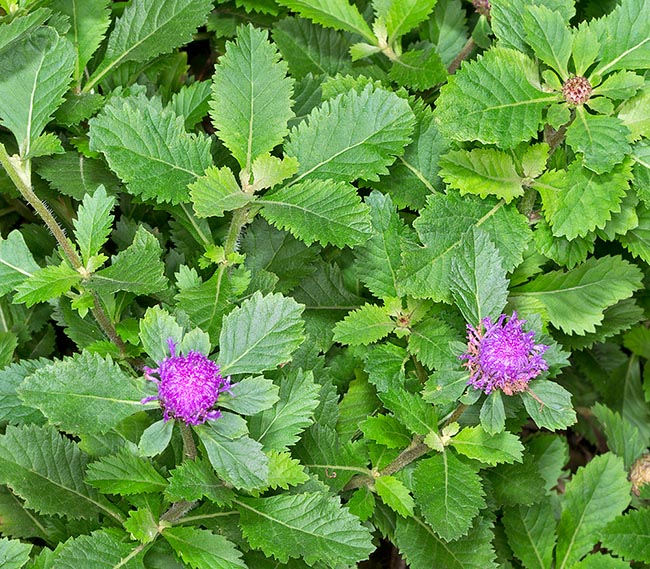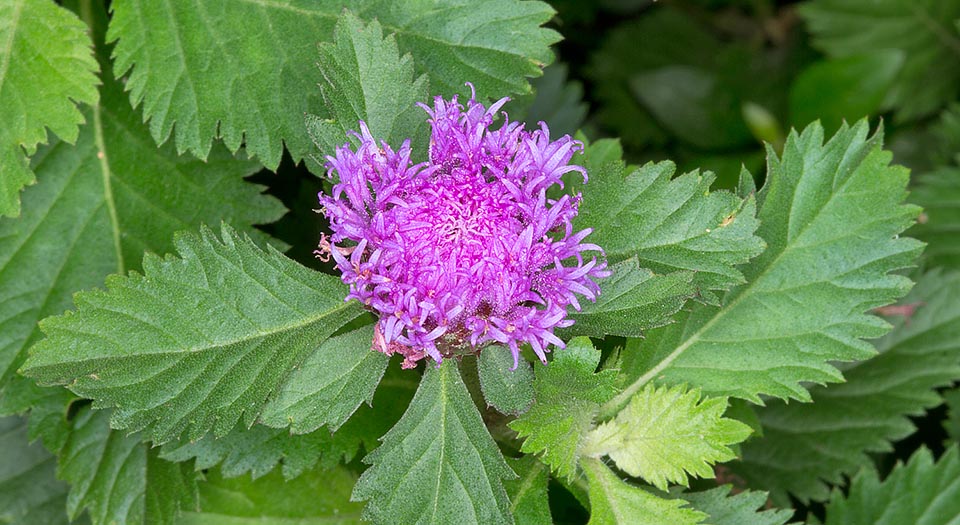Family : Asteraceae

Text © Pietro Puccio

English translation by Mario Beltramini

Centratherum punctatum is an about 70 cm tall perennial herbaceous species. Ornamental due to the leaves and long blooming is often used for borders or as soil cover in tropical gardens accepting dry and humid climates © Giuseppe Mazza
The name of the genus is the combination of the Greek substantives “κέντρον” (kentron) = point, spine and “αθηρ” (ather) = beard, with reference, after some, to the bristles of the pappus; the specific name is the Latin adjective “punctatus, a, um” = dotted with reference to the tiny glands present on the leaves.
Common names: Brazilian button flower, lark daisy, Manaos beauty, porcupine flower, purple flower (English); aletria, balainho-de-velho, botão-de-lapela, cravorana, melosa, perpétua-do-mato, perpétua-roxa, perpétua-roxa-do-mato, suspiro-de-cachorro, vassoura-roxa (Portuguese-Brazil); alcano, chupón, cravo de urubu, margarita, mejorana, siempreviva, verbena, virginia (Spanish).
The Centratherum punctatum Cass. (1817) is a usually erect perennial herbaceous species, up to about 70 cm tall, with pubescent cylindrical stem that ramifies in the upper part. The leaves, on short winged petiole, are simple, alternate, ovate to lanceolate with toothed margins and pointed apex, 2-8 cm long and 0,8-4 cm broad, dotted of tiny transparent glands, aromatic when crumpled.
Capitula, the typical inflorescences of the Asteraceae, terminal, solitary, sessile, sub-globose, of about 3,5 cm of diameter, formed by 30-60 hermaphroditic tubulose flowers (flosculous) inserted on a flat discoid base, the receptacle, surrounded by a hemispherical involucre, of 1-2 cm of diameter, formed by 30-50 bracts, the outer ones, 1-2 cm long, are foliaceous and curved, the inner ones, 0,6 cm long, scarious (membranous) and spinescent. Imbutiform corolla of lavender to purple colour, 0,8-1,4 cm long, with cylindrical tube and 5 linear lobes with pointed apex, about 3 mm long.
The fruits are achenes (or, better, cypselae) of pale brown colour, linear, striped, 1-2,5 mm long provided of caducous pappus formed by filiform scales of pale yellow colour, 1-3 mm long, that facilitate its dispersion through the wind. It easily self-disseminates so much to become invasive in several tropical countries. It easily reproduces by seed in draining organic loam, maintained humid at the temperature of 20-22 °C, with the first blooming occurring after about 3 months. Ornamental species of easy cultivation and of long flowering utilizable for borders and as soil cover in the gardens of the humid as well as relatively dry tropical and subtropical climate zones.

Native to tropical America and Australia has spread in various warm climate countries becoming often invasive. In full sun, in temperate climate, can be also cultivated as annual. The leaves, aromatic if rubbed, contain bioactive compounds with antimicrobic and antioxidant properties of possible use in medicine © Giuseppe Mazza
It requires an exposition preferably in full sun, moderate waterings and is not particular about the soil, bears well short periods of drought, but is sensitive to the low temperatures, values around the -1 °C destroy the aerial part whilst at root level it can resist up to about -3 °C; out from the tropical and subtropical zones may be cultivated as annual seen the precocious blooming. It adapts well to the cultivation in pot utilizing a particularly draining substratum rich of organic substance with regular waterings, but without stagnations, and fertilizations, in spring-summer, with products with high contents of phosphorus and poor contents of nitrogen.
Laboratory studies have evidenced the presence in the leaves of bioactive compounds with antimicrobic and antioxidant properties of possible use in medicine.
Synonyms: Spixia violacea Schrank (1819); Ampherephis aristata Kunth (1820); Ampherephis mutica Kunth (1820); Ampherephis intermedia Link (1822); Amphibecis violacea (Schrank) Schrank (1824); Crantzia ovata Vell. (1827); Ampherephis pilosa Cass. (1828); Ampherephis pulchella Cass. (1828); Centratherum brevispinum Cass. (1828); Centratherum longispinum Cass. (1828); Centratherum intermedium (Link) Less. (1829); Centratherum muticum (Kunth) Less. (1829); Centratherum pulchellum (Cass.) Steud. (1840); Centratherum brachylepis Sch. Bip. ex Baker (1873); Centratherum holtonii Baker (1873); Centratherum parviflorum Moric. ex Baker (1873); Centratherum punctatum var. parviflorum Baker (1873); Baccharoides brachylepis (Sch. Bip. ex Baker) Kuntze (1891); Baccharoides holtonii (Baker) Kuntze (1891); Baccharoides muticum (Kunth) Kuntze (1891); Baccharoides punctatum (Cass.) Kuntze (1891); Baccharoides violaceum (Schrank) Kuntze (1891); Centratherum aristatum Cass. ex B.D. Jacks. (1895); Centratherum punctatum var. foliosum Chodat (1902); Centratherum punctatum fo. brachyphyllum Hassl. (1913); Centratherum punctatum fo. foliosum (Chodat) Hassl. (1913); Centratherum punctatum subsp. camporum Hassl. (1913); Centratherum punctatum var. longipes Hassl. (1913); Centratherum violaceum (Schrank) Gleason (1922); Centratherum punctatum var. viscosissimum Hassl. (1913); Centratherum camporum (Hassl.) Malme (1931); Centratherum camporum var. longipes (Hassl.) Malme (1931).
→ To appreciate the biodiversity within the ASTERACEAE family please click here.
